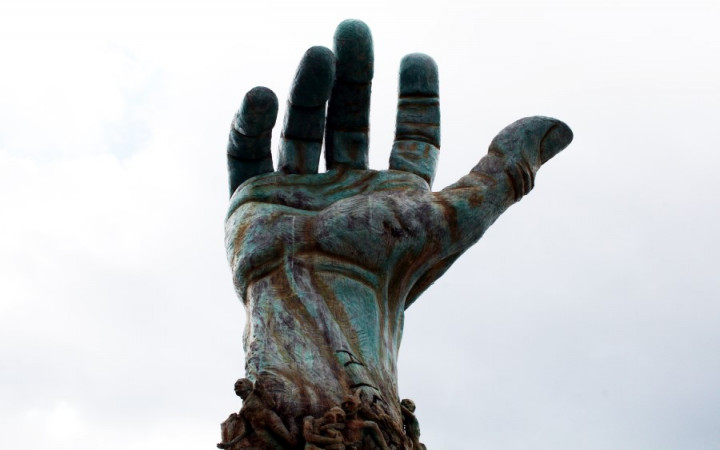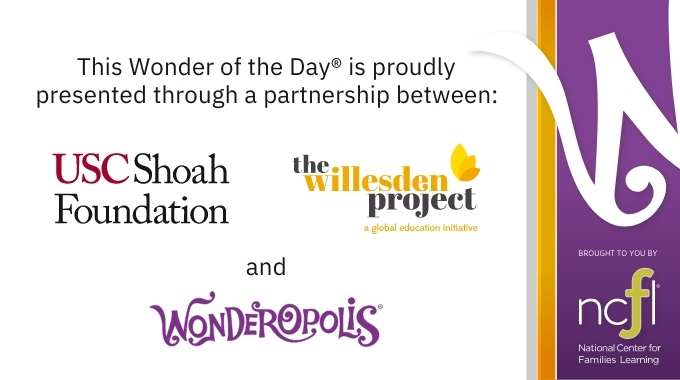Today’s Wonder of the Day was inspired by Sofia. Sofia Wonders, “What happened in the Holocaust?” Thanks for WONDERing with us, Sofia!
The Holocaust was one of the most tragic and terrible events in human history. It began in January 1933, when the Nazi party was elected to power in the Weimar Republic (Germany between World War I and World War II). It ended in Nazi Germany’s defeat at the end of World War II in 1945.
The Nazis believed that true, pure Germans were racially superior to those who did not have what they called “pure blood.” Under Adolf Hitler’s leadership, Nazi Germany began to persecute those they saw as different and inferior: Jews, Communists, LGBTQ+ people, Roma and Sinti, Jehovah’s Witnesses, and anyone who was not white. Hitler blamed the Jews and Communists for Germany losing World War I. In his book, “Mein Kampf,” he promised to rid Germany of all the Jews when he ruled the country.
While Hitler received support from millions of Germans, many did not believe he would do the things he said. However, he began working toward his goal as soon as he became Chancellor of Germany in January 1933. New laws were enacted that robbed Jews of their rights.
If you watched the video in today’s image gallery, you heard testimony from Ellen Kerry Davis. As a Jewish child, Davis witnessed the changes in Germany after Hitler’s rise to power. In the video, she shared that even long-time family friends were afraid to be seen speaking to Jews in public. Unfortunately, Jewish families and children across Europe had similar experiences.
As time went on, the Nazis continued to persecute Jews. On November 9-10, 1938, many Jewish businesses, synagogues and homes were vandalized or burned. This event has become known as Kristallnacht, or the “Night of Broken Glass.” By this time, Nazi Germany had annexed and invaded Austria and parts of Czechoslovakia.
Throughout World War II, Jews in Nazi-occupied Europe and parts of North Africa were persecuted. Jews were forced to live in cramped quarters called ghettos. Ghettos were circled by barbed wire and armed guards, and living conditions were very bad. People there struggled to find things they needed, like food and medicine.
From ghettos, Jews were taken to concentration camps. There, they were forced to do hard labor. Many people died from diseases and starvation in these camps. Many others were killed simply because they were Jewish. Nazis murdered Jewish people as part of Hitler’s “Final Solution.” They did so through mass shootings and poison gas; then, they burned the bodies.
The word “Holocaust” comes from the Greek words meaning “sacrifice by fire.” By the end of World War II, the Nazis had killed about six million Jews. Of this number, experts believe over one million were children. Historians have debated the total death toll from the Holocaust. Some say the Nazis murdered about 12 million people. Others believe the total could be closer to 20 million.
It’s important to remember that the actions of Hitler and the Nazi party did not take place in a void. The crimes they committed were only possible because of widespread antisemitism across Europe and much of the world, including the United States. Governments, police forces, and citizens outside of Germany aided in the violence. Many profited from the crimes, taking the property and valuables left behind by victims of the Holocaust.
However, some people stood up against Hitler and the Nazis. They did so at great risk to their personal safety, and many of these individuals lost their lives. Today, many remember the legacy of these brave people and honor the victims of the Holocaust through allyship.
Since 2005, International Holocaust Remembrance Day has been observed on January 27. On that date in 1945, the concentration camp named Auschwitz was liberated by Soviet Armed Forces. On this day, we remember the victims of the Holocaust and we honor their memory and legacy.
Have you ever seen a person being treated unfairly? Have you ever witnessed racism, sexism, or another form of discrimination? The Holocaust reminds us of why it’s important to become an upstander, not a bystander, in these situations. Talk with a trusted adult about what you can do to protect people facing persecution.
Preserving memories are a vital part of the human experience, and USC Shoah Foundation’s Visual History Archive contains over 55,000 testimonies from survivors and witnesses—using audio and video—to educate future generations about the Holocaust and other atrocities, in support of the Institute’s mission to develop empathy, understanding, and respect through testimony so the next generation understands the importance of learning from the Holocaust and making the world a better place. Its IWitness platform contains many of these testimonies that were gathered using recorded interviews to tell the stories of survivors and witnesses.
Standards: CCRA.L.3, CCRA.L.6, CCRA.R.1, CCRA.R.2, CCRA.R.4, CCRA.R.10, CCRA.SL.1





